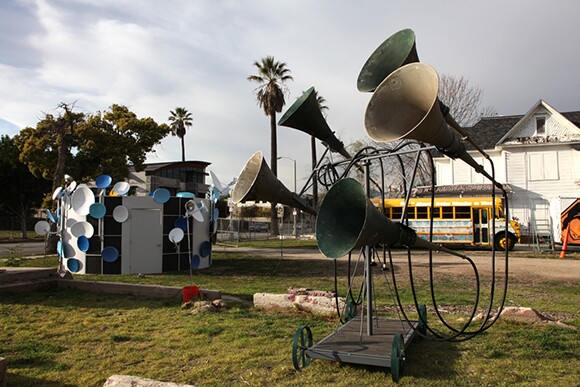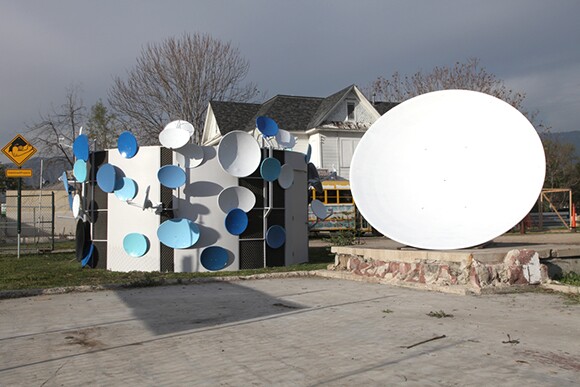Elana Mann Tunes Noise Out to Let the Signal In

Cut off by the 134 freeway from the rest of the city, Northwest Pasadena can sometimes feel a world apart from its more prosperous neighbors. "We're on the wrong side of the tracks here," says Emily Hopkins, Executive Director of Side Street Projects, an artist-run nonprofit that eschews the gallery exhibitions in favor of working within communities. By virtue of a few mobile trailers parked in a mostly empty lot, it has made Northwest Pasadena its headquarters.
According to Hopkins, Northwest Pasadena is the most densely populated area in the city, many of its residents live at or below poverty levels and nearly a quarter of whom do not speak English well. The figures may help explain attendance at the community meetings. "Honestly, every time I've been to the meetings, there haven't been any community members there," says artist Elana Mann. "This community feels like they don't have a voice," says Mann.
Enter Mann's recently launched Listening as (a) Movement project. "There's a larger issue in Pasadena where there is this set group of people that go to meetings and they're intimidating," says Hopkins, who shepherded Mann through the grant process that funded "Listening as (a) Movement." Though the city has been making efforts to reach out to the community by establishing the Northwest Commission, the only neighborhood-specific commission in the city, and ArtNight Pasadena, Mann says it has been difficult to get the community engaged. "Then there are people who genuinely care about the community but don't go to meetings. This project gives people the opportunity to listen to the neighborhood in a different way."
Mann unveiled three outdoor sound sculptures inspired by pre-radar sonic technologies during ArtNight Pasadena. "I was inspired by listening technology that's passive used between World War I and II. It was all just amplifying sound in different ways. People would listen for planes coming and stuff like that."
Though her three sculptures are all unnamed, one cannot pass by the open lot of Side Street Projects without taking a second look. White and blue parabolas and horns abound.

Mann's simplest piece is a concave white metal disc, propped at an angle, much like a decorative plate on the kitchen shelf. Unlike its domestic look-alike, the "Giant Satellite Dish" as it is nicknamed provides many exciting acoustic possibilities, as composer Allison Johnson illustrated at the ArtNight launch. Johnson used the disc as a make-do percussion instrument. With it, Johnson set an irrepressible beat that had audiences inadvertently tapping their feet and clapping their hands to the rhythm.
In contrast to the disc's simplicity is a more complicated sculpture Mann designed with acoustic engineer Marshall Long. The "Round Room" as it's called is essentially a doughnut-shaped space sprinkled by satellite dishes painted blue, white and light green on the outside. Visitors can enter the generous interior by way of a discreet white door to the side. A smaller room lies at its core, which only has space for a handful of people.
As one goes deeper and deeper into the round room, the sounds from the freeway become more muffled, while an interior dialog is perhaps beginning. By painting the interior a bright white, Mann blocks out even more visual cues, leaving only the auditory senses to rely on. "When you go inside, it's so bright. You can't really look anymore, you just have to rely on your ears," says Mann.

During ArtNight, Johnson and four other drummers surrounded the round room and used its satellite dishes as drums. Using slingshots, glow sticks, and rubber balls, the impromptu band jammed. Though it might look spontaneous, the musicians were all attuned to each other. At different intervals one musician would take the lead. Imperceptible hand signals would crisscross between the band, indicating different approaches.
Mann's final piece is a throwback from history. The artist borrowed announcement horns used from the Rose Bowl's horse-and-buggy days and mounted them on a rotating frame. Instead of broadcasting, Mann turned the horns' purpose around. Earpieces trailed behind the horns, so visitors could in effect listen to its surroundings.
Over the course of the month, Mann's pieces will become both stage and instrument, paving the way for the community to come together. One of the most awaited events is scheduled April 11. On that day, young people from nonprofit DayOne will speak with the Northwest Commission for a "non-meeting meeting" says Mann, i.e. a meeting that doesn't feel like a boring conversation within a public office. The dialog will initiate a yearlong project the two will work on together.
Though playful in appearance, Mann's work is a multi-layered project informed by the virtue of true empathy. On one level, her sound sculptures are entertaining. It affects visitors like a new toy does a child, they can't help but explore and discover new applications.
On a deeper level, the sculptures are outrageous totems that deliberately make a space for listening in a noisy, noisy world where constant stream of information makes it difficult to focus on the truly important.

Though trained as a visual artist, Mann's interest in listening has been growing for the past few years. It began as she was driving around Los Angeles, listening to accounts of car bombs going off in Iraq. Seeing unintended parallels, Mann recorded interviews with Captain Dylan Alexander Mack, a war veteran, which would eventually become "Can't Afford the Freeway" a video that had the artist responding to the veteran's recorded tale while in her car.
"This was a guy who was prepared to go to war with me. He didn't mind that part much but what really affected him was coming back and dealing with emotional burden of what happened alone. It was like nobody was listening to him," says Mann, "He was moved by the fact that [with the piece] I was trying to empathize with his story and listening to him."
Mann followed this up with her involvement inARLA, a collective that used active listening strategies formulated by composer Pauline Oliveros. The group made the act of listening a spectacle. Instead of harsh slogans, they held huge crafted ears aloft during Occupy Los Angeles, symbolically reminding those on both fronts to listen.
The artist's ongoing investigation is a reminder we all need these days. Listening, really listening, is a dying art, says Mann. "We communicate a lot through monologuing -- where I'm going to monologue at you through email or through text. Two-way dialogue is being lost."
Dig this story? Sign up for our newsletter to get unique arts & culture stories and videos from across Southern California in your inbox. Also, follow Artbound on Facebook and Twitter.